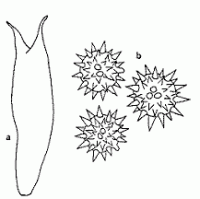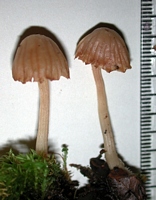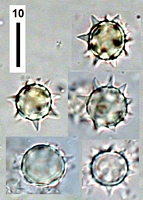|
 Laccaria echinospora Laccaria echinospora
SynonymsAgaricus echinosporus
BiostatusPresent in region - Exotic
Images (click to enlarge)
Caption: L. echinospora: a, basidium; b, spores. | 
Owner: J.A. Cooper | 
Owner: J.A. Cooper |
Article: McNabb, R.F.R. (1972). The Tricholomataceae of New Zealand. 1. Laccaria Berk. & Br. New Zealand Journal of Botany 10(3): 461-484 (http://www.rsnz.org/publish/abstracts.php).
Description: PILEUS: 0,3-1.5 cm diam., convex when young, plano-convex,
applanate, or occasionally centrally depressed at maturity, often variously
deformed, hygrophanous, non-viscid, pellucid-striate at margins under wet conditions,
glabrous, often faintly pruinose when dry, pinkish brown to reddish brown, drying
pallid buff. Cuticle composed of unspecialised, repent, parallel or slightly
interwoven, thin-walled, clamped hyphae 6-11 µm diam. LAMELLAE: adnexed, adnate,
or subdecurrent, distant, intermixed, thick, to 3 mm deep, pink, glaucous. STIPE:
0.6-1.8 cm long, ± equal, 1-2 mm diam., dry, hollow, finely longitudinally fibrillose,
concolorous with pileus; flesh concolorous with exterior; basal mycelium white.
SPORES: spore print white when fresh; spores globose
to subglobose, apiculate, hyaline, inamyloid, coarsely echinulate, 16-21 µm
diam. including spines, spines 2-3-(3.5) µm long, to 2.5 µm diam. basally. HYMENIUM:
basidia hyaline, stout, broadly cylindrical to clavate, 40-53 X 11-13 µm, 2-spored,
sterigmata to 12 µm long; paraphyses absent. HYMENOPHORAL TRAMA: regular, composed
of tinted, ± parallel, long-celled hyphae; clamp connections present. CONTEXT
OF PILEUS: thin, concolorous with exterior. SMELL AND TASTE: not distinctive.
CHEMICAL CHARACTERS : FeSO4 on pileus and context—rapidly dark grey; KOH and
NH4OH on pileus and context—n.r.
Habitat: Gregarious to caespitose under native and introduced
trees and shrubs.
Notes: This species is frequently described under Laccaria
tortilis ([Bolt.] S. F. Gray) Cooke. The identity of L. tortilis is
a matter of conjecture as interpretation of the species rests on Bolton's illustrations
and brief description. Many mycologists retain the epithet tortilis for the
large-spored Laccaria with bisporous basidia (Orton, 1960), but Singer (1952)
considered that L. tortilis was a small-spored species and regarded Rea's (1922)
interpretation as the correct one. Singer (1943) took up the epithet echinospora,
which was originally applied to a South American species by Spegazzini, for
this large-spored Laccaria. As the type of L. echinospora is still in
existence. Singer's choice of names has been followed.
L. echinospora is widely distributed
throughout temperate regions of the Northern Hemisphere, and in temperate South
America where it occurs under both native and introduced trees (Singer, 1952).
The species is readily recognisable by the small, often distorted fructifications,
bisporous basidia, and large coarsely echinulate spores. L. echinospora
has not previously been recorded from New Zealand, and from the few collections
it is not possible to decide whether it is an indigenous species. Stevenson
(1964) stated that her record of L. tortilis from this country applied
to a small-spored species.
|